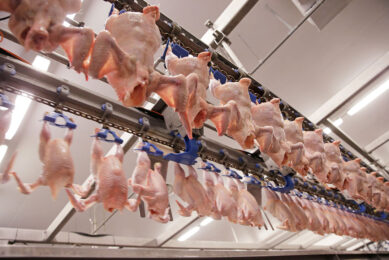Securing carcass quality and food safety

Salmonella Enteritidis and Campylobacter jejuni are major causes of broiler carcass contamination. Rinse methods can help reducing their spread. Adequate sampling is necessary however.
By Manpreet Singh, Purdue University, West Lafayette and Jacob Smith Auburn University, Auburn
Salmonella and Campylobacter spp. are major human pathogens associated with poultry products, which are attributed to more foodborne deaths than any other food product. Annual estimates attribute human salmonellosis and campylobacteriosis to approximately one million episodes of foodborne illness each year in the United States. Both Salmonella and Campylobacter spp. are commensal residents of the poultry gastrointestinal tract and the primary processing of such livestock can contribute to their spread. To combat this issue the United States Department of Agriculture-Food Safety Inspection Service (USDA-FSIS) implemented stringent Campylobacter performance standards and updated pre-existing Salmonella performance standards.
The compliance to such standards is projected to result in the reduction of more than 5,000 Campylobacter infections in the United States each year alone. Acute diagnosis of campylobacteriosis includes symptoms such as fever, headache, muscle pain, diarrhoea that frequently contains blood and mucus, and severe abdominal cramps while chronic signs associated with Campylobacter infection include Guillain-Barré syndrome and reactive arthritis. The symptoms of Salmonella infection in humans are similar to Campylobacter and appear 12 to 72 hours after initial exposure. Since these pathogens are commensals to poultry, predicting the Salmonella and Campylobacter infection status of poultry pre-mortem is difficult due to the lack of clinical manifestation.
Effective control
Implementation of new and more
stringent regulatory guidelines has necessitated poultry processors to employ innovative or additional pathogen intervention strategies for more effective control of Salmonella and Campylobacter throughout processing. In the US, broiler processing facilities are required to comply with the performance standards of the USDA-FSIS. Previous performance standards for broilers focused solely on controlling Salmonella, requiring the prevalence of Salmonella-positive samples to be less than 20% (12 positive samples out of 51 samples).
However, new pathogen reduction data collected during the USDA nationwide baseline studies, as well as the failure to achieve “Healthy People 2010” targets became the driving force for implementing updated performance standards for Salmonella and developing standards for Campylobacter for the first time in the agency’s history. New performance standards require the prevalence of Salmonella-positive samples to be below 7.5% (five positive samples out of 51 samples). Likewise, in the new regulations, Campylobacter-positive samples should be less than 10.4% (eight positive samples out of 51 samples). The USDA-FSIS whole carcass rinse method for bacterial recovery from poultry carcasses uses 400 ml of sterile Buffered Peptone Water and carcasses are rinsed by continuously inverting them back and forth for 60 seconds. Oftentimes researchers use lower rinse volumes to increase the detection of inoculated pathogens. The recovery of Salmonella spp. on chicken carcasses was comparable when using both 100 and 300 ml rinses even with low inoculation levels. Using a 200 ml carcass rinse was also more effective than using the sponge method on turkey carcasses.
Bacterial inoculation
Based on mixed reports available in the literature and limited information available on the impact of recovery of either Salmonella or Campylobacter from poultry carcasses given the possibility of both pathogens being present in the processing plants, a study was designed to evaluate bacterial inoculation (Salmonella Enteritidis and Campylobacter jejuni, either alone or combined), attachment period (0 and 30 min), and carcass rinse volume (200 and 400 ml) on the recovery of S. Enteritidis and C. jejuni from inoculated broiler carcasses. Commercially processed broiler carcasses were purchased and held at 4°C. S. Enteritidis was grown aerobically in BHI broth at 37°C for 18h and C. jejuni was grown micro aerobically in Campylobacter Enrichment Broth at 42°C for 18h. Carcasses were inoculated with 10 ml of S. Enteritidis or C. jejuni, either alone or mixed, and allowed either 0 or 30 min bacterial attachment period. The carcasses were then transferred to a sterile rinse bag and rinsed using the USDA-FSIS carcass rinse method with either a 200 or 400 ml Buffered Peptone Water rinse (Figure 1 and 2).
Recovery of S. Enteritidis and C. jejuni were enhanced in mixture in both the 200 and 400 ml carcass rinses, irrespective of bacterial attachment period. Furthermore, recovery was not significantly impacted but greater using a 200 ml rinse instead of a 400 ml rinse. Given the common perception about low recovery of Campylobacter spp. when present in conjunction with other pathogens in the environment or on poultry carcasses, the study has demonstrated that a mixture of S. Enteritidis and C. jejuni can be used for broiler carcass inoculation instead of separate inoculation procedures, therefore closely simulating in-plant contamination scenarios and a 200 ml rinse provides high recovery of both pathogens. Additionally, a 200 ml rinse will assist in the practical purposes of reducing incubator space when enriching samples and provide general cost savings when compared to a 400 ml rinse.
Lower volume rinses
In order to maintain an effective food safety programme it is important to examine the sampling methods being currently used. This work assesses
the sensitivity of methods which are presently used with the intention to
justify the use of lower volume carcass rinses. Although the recovery of both Salmonella and Campylobacter spp. in this study were not significantly increased by the lower rinse volumes, there was a slight enhancement using the 200 ml rinse. The advantages of using a lower volume rinse that will consistently and effectively detect both Salmonella and Campylobacter spp. are the use of less enrichment medium and decreased incubator space in the laboratory. Additionally, the concentration of bacterial cells is greater at the end of incubation and, therefore, enhances the probability to detect target organisms when using subsequent selective plating and enrichment procedures.












